A Digital-Twin Evaluation of Net Zero Energy Building for Existing Buildings
Abstract
1. Introduction
1.1. Defining the Balance
- Net Zero Site Energy: A site ZEB produces at least as much energy as it uses in a year when accounted for at the site.
- Net Zero Source Energy: A source ZEB produces at least as much energy as it uses in a year when accounted for at the source. Source energy refers to the primary power used to generate and deliver the energy to the site. To calculate a building’s total source energy, imported and the appropriate site-to-source conversion multiply exported energy.
- Net Zero Energy Costs: In a cost ZEB, the amount of money the utility pays the building owner for the energy the building exports to the grid is at least equal to the amount the owner spends the efficiency for the energy services and energy used over the year.
- Net Zero Energy Emissions: A net-zero emissions building produces at least as much emissions-free renewable energy as it uses from emissions-producing energy sources.
1.2. Grid Connection
1.3. The Comparison between on-Site and off-Site Energy Production
1.4. Energy Conversion Factors
1.5. Energy Production Methods
2. Methods
2.1. Hierarchical Flow Chart
2.2. Building Information Model (BIM)
Choice of Building
2.3. Thermal Property of the Building Model
2.4. Energy and Cost Analysis of Model
3. Results
3.1. The Results of Energy and Cost Analysing Model
3.2. Renewable Technologies with NZEB
3.2.1. Photovoltaic Panels
3.2.2. Wind Power
3.2.3. Biomass
4. Discussion
- The reference building for the BIM would be a larger building, such as a high rise block of flats, as this is more likely the type of building, which will be constructed and needed in the future of urban areas.
- The details about installing renewable energy should be included in the NZEB model for further study; for example, infiltration, internal gains, plug loads, to make the NZEB model more accuracy.
- More improvements would be suggested for existing building to assess whether they can meet the NZEB goal. Also, this would allow for not just an evaluation of future buildings, but instead all buildings in the future.
- More renewable energy technologies would be explored, and their potential application to the building would be assessed, along with renewable energy imports. It would allow for a more thorough analysis and could potentially highlight cheaper and more feasible options.
5. Conclusions
Author Contributions
Funding
Acknowledgments
Conflicts of Interest
Appendix A
| Rank | NZEB Definition | Meaning |
|---|---|---|
| 1 | NZEB: A | The buildings energy demand is met 100% by renewable technologies situated on the building footprint and no energy is imported. Any excess energy produced will be sold back to the energy grid |
| 2 | NZEB: B | The buildings energy demand is met 100% by renewable technologies situated on the buildings site and no energy is imported. Any excess energy produced will be sold back to the energy grid |
| 3 | NZEB: C (Source) | A building which meets its energy demand through a combination of imported energy and renewable technologies, with the technologies being located either on the building footprint (preferred) or site. The energy imported is balanced by the renewable energy produced when all energy for generation and transmission, the correct site-to-source conversion factors must be applied |
| 4 | NZEB: Mix (Source) | A building which meets its energy demands through the on-site combustion of imported renewable fuels, along with imported energy and on-site energy production through other renewable energy technologies. The energy imported is balanced by the renewable energy produced when all energy for generation and transmission, the correct site-to-source conversion factors must be applied |
| 5 | NZEB: C (Emissions) | A building which meets its energy demand through a combination of imported energy and renewable technologies, with the technologies being located either on the building footprint (preferred) or site. The energy imported from emission producing sources is balanced by an equal amount of energy from emission free sources. |
| 6 | NZEB: Mix (Emissions) | A building which meets its energy demands through the on-site combustion of imported renewable fuels, along with imported energy and on-site energy production through other renewable energy technologies. The energy imported from emission producing sources is balanced by an equal amount of energy from emission free sources. |
| 7 | NZEB: D | A building which 100% of its energy demand is met through the imports of energy from a renewable source |
| 8 | NZEB: C (Site) | A building which meets its energy demand through a combination of imported energy and renewable technologies, with the technologies being located either on the building footprint (preferred) or site. These technologies produce as much energy as the building consumes in the year, not including energy for transmission |
| 9 | NZEB: Mix (Site) | A building which meets its energy demands through the on-site combustion of imported renewable fuels, along with imported energy and on-site energy production through other renewable energy technologies. These technologies produce as much energy as the building consumes in the year, not including energy for transmission |
| 10 | Autonomous NZEB | This is a building which is not connected to the grid, therefore any energy it uses must come from its own production, these production methods must be from either renewable technology or combustion of renewable fuels. The lack of grid connection means on site storage must be utilised, however the building may still experience periods with no energy. |
Appendix B
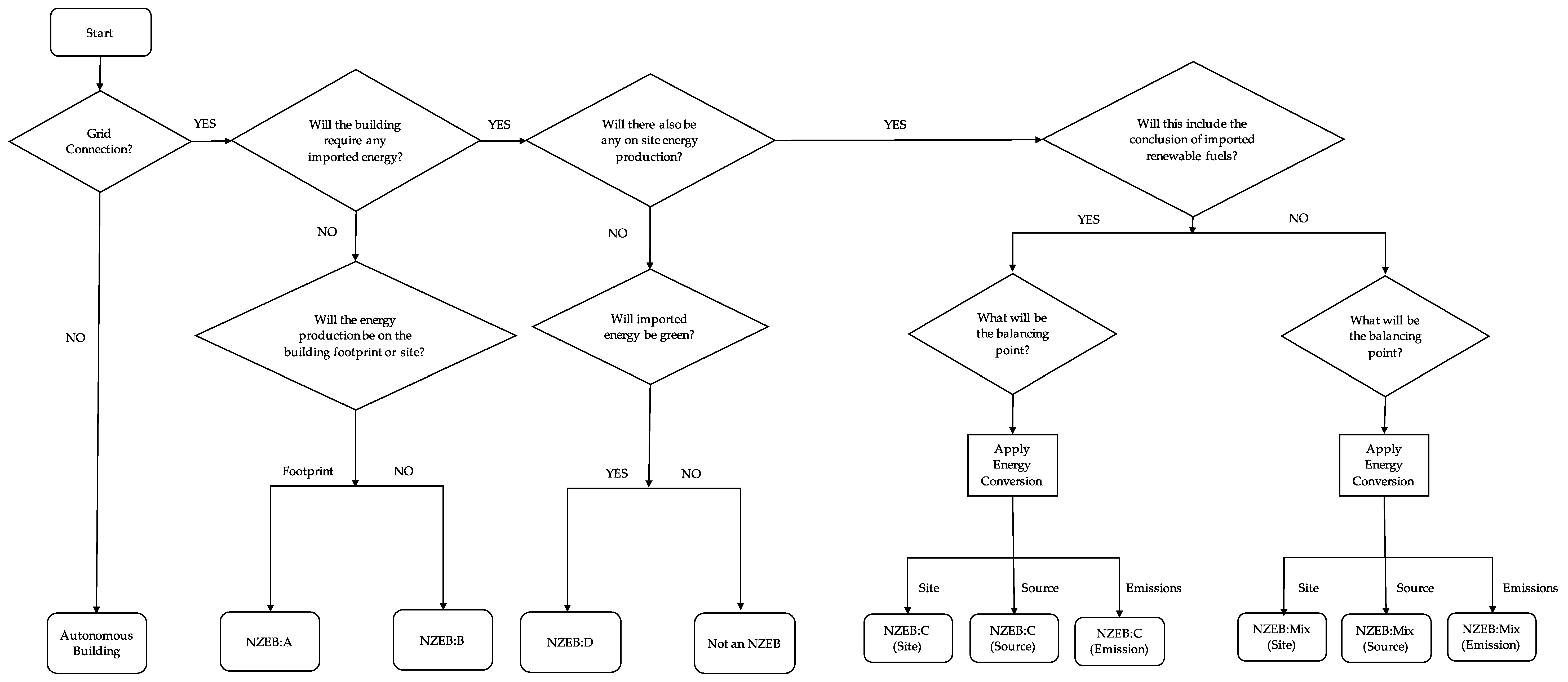
Appendix C
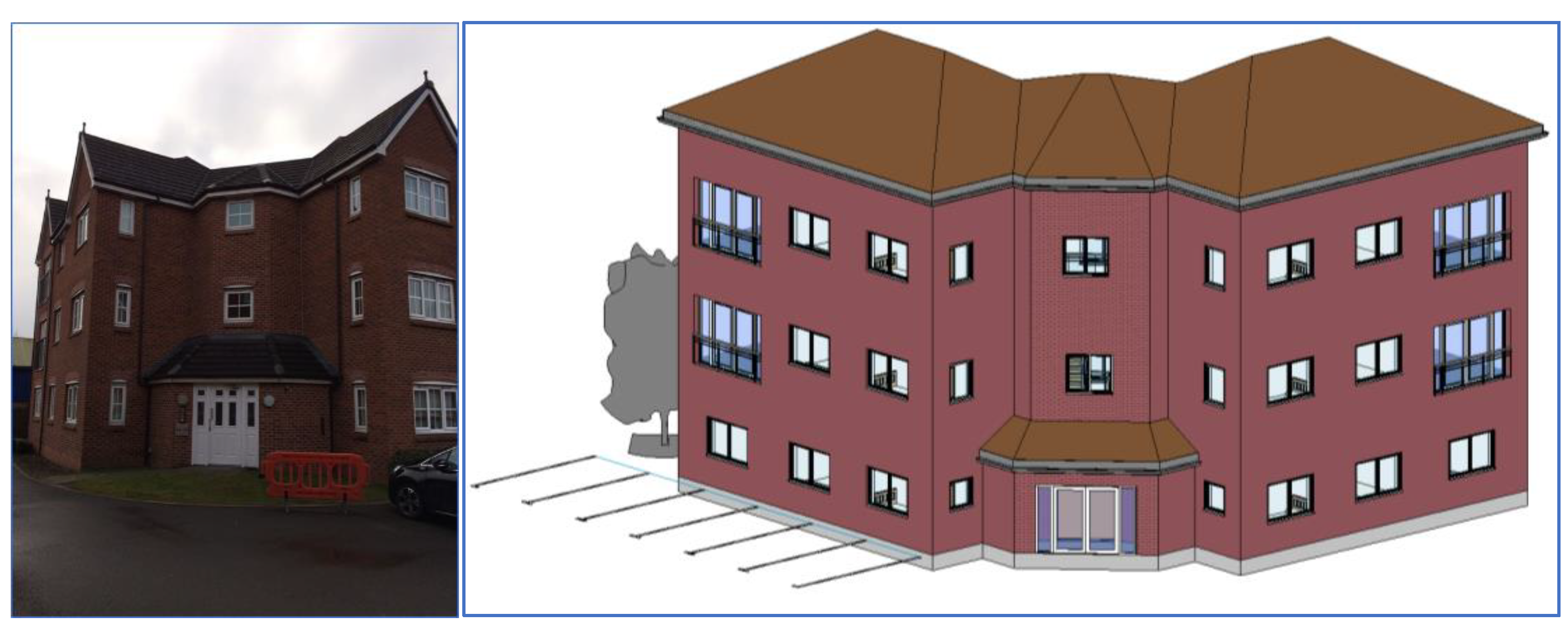

Appendix D
| Item | Revit (Standard) | Standard House | Increased Efficiency |
|---|---|---|---|
| Wall (mm) | R = 4.2 U = 0.24 | R = 2.607 (from values below) | R = 5.3346 (from values below) |
| Brick (102.5) | K = 0.54 | 0.69–1.32 [62] | 0.6 [63] |
| Insulation (75) | K = 0.019 | 0.038 [64,65] | 0.021 [63] |
| Concrete (100) | K = 1.3 | 0.19 [63] | 0.11 [63] |
| Plaster board (12.5) | K = 0.51 | 0.48 [62] | 0.022—(insulated plaster board) [66] |
| Base coat (2) | 0.018 (Ecomerchant.co.uk, 2018) | ||
| Plaster (2) | K = 0.65 | 0.5 [67] | 0.5 |
| Roof (mm) | R = 9.3383 U = 0.107 | R = 4.2516 (from values below) | R = 15.4084 (from values below) |
| Tiles (38) | K = 0.84 | 0.84 [67] | 0.11—Western red cedar [64,65] 0.12—(Terrazzo tiles) [67] |
| Wood (lath) (25) | K = 0.12 | 0.12 [67] | 0.12 |
| Felt (2) | K = 0.5 | 0.5 [69] | 0.19—roofing felt [68] |
| Wood (board) (25) | K = 0.12 | 0.14 [69] | 0.14 |
| Insulation (100) | K = 0.035 | 0.038 [64,65] | 0.021 [63] Ensure 270 mm thick [27,28] |
| Wood (truss) (150) | K = 0.025 | 0.13 [69] | 0.13 |
| Plaster board (12.5) | 0.48 [70] | 0.022—(insulated plaster board) [68] | |
| Base coat (2) | 0.018 [68] | ||
| Plaster (2) | K = 0.65 | 0.5 [69] | |
| Window | R = 0.667; U = 1.5 (Double glazed, 16 mm gap with argon filling) [69,70] | R = 1.42; U = 0.8 (Triple glazed, 16 mm gap with argon filling) [67] | |
| Door | R = 1.03 U = 0.97 | U = 1.8 [70] | R = 1.42; U = 0.8 (Triple glazed, 16 mm gap with argon filling) [67] |
References
- European Union. Directive 2010/31/EU of the European Parliament and of the Council of 19 May 2010 on the energy performance of buildings (recast). Off. J. Eur. Union 2010, 153, 13–35. [Google Scholar]
- US Department of Energy. 2015 Renewable Energy Data Book; US Department of Energy: Washington, DC, USA, 2015; p. 14.
- Srinivasan, R.S.; Braham, W.W.; Campbell, D.E.; Curcija, C.D. Re (De) fining Net Zero Energy: Renewable Emergy Balance in environmental building design. Build. Environ. 2012, 47, 300–315. [Google Scholar] [CrossRef]
- Wang, L.; Gwilliam, J.; Jones, P. Case study of zero energy house design in UK. Energy Build. 2009, 41, 1215–1222. [Google Scholar] [CrossRef]
- Voss, K.; Musall, E. Net Zero Energy Buildings—International Projects on Carbon Neutrality in Buildings; DETAIL; Walter de Gruyter: Berlin, Germany, 2011; ISBN -978-3-0346-0780-3. [Google Scholar]
- Sartori, I.; Napolitano, A.; Voss, K. Net zero energy buildings: A consistent definition framework. Energy Build. 2012, 48, 220–232. [Google Scholar] [CrossRef]
- Crawley, D.; Pless, S.; Torcellini, P. Getting to net zero. ASHRAE J. 2009, 51, 18–25. [Google Scholar]
- European Parliment. On the Proposal for a Directive of the European Parliament and of the Council on the Energy Performance of Buildings (Recast); European Parliament: Brussels, Belgium, 2009. [Google Scholar]
- Marszal, A.; Heiselberg, P.; Bourrelle, J.; Musall, E.; Voss, K.; Sartori, I.; Napolitano, A. Zero Energy Building—A review of definitions and calculation methodologies. Energy Build. 2011, 43, 971–979. [Google Scholar] [CrossRef]
- Noguchi, M.; Athienitis, A.; Delisle, V.; Ayoub, J.; Berneche, B. Net Zero Energy Homes of the Future: A Case Study of the ÉcoTerraTM House in Canada. In Proceedings of the Renewable Energy Congress, Glasgow, Scotland, 19–25 July 2008. [Google Scholar]
- Heinze, M.; Voss, M. Goal zero energy building—Exemplary experience based on the solar estate Solarsiedlung Freiburg am Schlierberg. Ger. J. Green Build. 2009, 4. [Google Scholar]
- Musall, E.; Weiss, T.; Lenoir, A.; Voss, K.; Garde, F.; Donn, M. Net Zero Energy Solar Buildings: An Overview and Analysis on Worldwide Building Projects. In Proceedings of the EuroSun Conference 2010, Graz, Austria, 28 September–1 October 2010. [Google Scholar]
- Zhao, J.; Wu, Y.; Zhu, N. Check and evaluation system on heat metering and energy efficiency retrofit of existing residential buildings in northern heating areas of china based on multi-index comprehensive evaluation method. Energy Policy 2009, 37, 2124–2130. [Google Scholar] [CrossRef]
- Pless, S.; Torcellini, P. Net-Zero Energy Buildings: A Classification System Based on Renewable Energy Supply Options Net-Zero Energy Buildings; Contract; National Renewable Energy Laboratory: Golden Colorado, CO, USA, 2010.
- Srinivasan, R.S.; Campbell, D.E.; Wang, W. Renewable Substitutability Index: Maximizing Renewable Resource Use in Building. Building 2015, 5, 581–596. [Google Scholar] [CrossRef]
- Visa, I.; Moldovan, M.D.; Comsit, M.; Duta, A. Improving the renewable energy mix in a building toward the nearly zero energy status. Energy Build. 2014, 68, 72–78. [Google Scholar] [CrossRef]
- Krarti, M.; Ihm, P. Evaluation of net-zero energy residential buildings in the MENA region. Sustain. Cities Soc. 2016, 22, 116–125. [Google Scholar] [CrossRef]
- Portuguese Government. Decreto-Lei nr. 80/2006, Regulamento das Características do ComportamentoTérmico dos Edifícios (RCCTE); Portuguese Parliament: Lisbon, Portugal, 2006.
- UK Government. The Building Regulation 2000, Part L: Conversation of Fuel and Power; British Parliament: London, UK, 2000.
- Torcellini, P.; Pless, S.; Deru, M. Zero Energy Buildings: A Critical Look at the Definition Preprint. ACEE Summer Study 2006, 2, 15. [Google Scholar] [CrossRef]
- Sartori, I.; Napolitano, A.; Marszal, A.; Pless, S.; Torcellini, P.; Voss, K. Criteria for Definition of Net Zero Energy Buildings Criteria for Definition of Net Zero Energy Buildings. In Proceedings of the International Conference on Solar Heating, Cooling and Buildings 2010, Graz, Austria, 28 September–10 October 2010. [Google Scholar]
- Ballantyne, E.; Gurr, T.; Hill, R. Energy Considerations: Housing 2000; Report vol. 2; Australian Industrial Research Group and Commonwealth Scientific Industrial Research Organization (CSIRO) Division of Building Research: Canberra, Australia, 1980. [Google Scholar]
- Edwards, P.J.; Stewart, P.J.; Tucker, S.N. A CAD-based Approach to Embodied Energy Impact Modelling for Housing Design. In Proceedings of the National Construction and Management Conference, Sydney, Australia, 17–18 February 1994; Wakefield, R.R., Carmichael, D.G., Eds.; Institution of Engineers: Kensington, N.S.W., Australia, 1994; pp. 255–265. [Google Scholar]
- D’Cruz, N. Study on Environmental and Energy Bricks and Tiles; Curtin Consultant Services, Curtin University of Technology: Perth, Australia, 1990. [Google Scholar]
- Lawson, B. Capital Energy Costs of Building and Recycling of Building Materials. In Proceedings of the Construction Beyond 2000, Espoo, Finland, 15–18 June 1992. [Google Scholar]
- House Price per Square Metre and House Price per Room, England and Wales: 2004 to 2016. Available online: https://www.ons.gov.uk/economy/inflationandpriceindices/articles/housepricepersquaremetreandhousepriceperroomenglandandwales/2004to2016 (accessed on 14 December 2017).
- How Much Electricity does a Home Use? Available online: https://www.ovoenergy.com/guides/energy-guides/how-much-electricity-does-a-home-use.html (accessed on 15 December 2017).
- The Ultimate Guide to Roof and Loft Insulation | OVO Energy. Available online: https://www.ovoenergy.com/guides/energy-guides/the-ultimate-guide-to-roof-and-loft-insulation.html (accessed on 10 February 2018).
- Leckner, M.; Zmeureanu, R. Life cycle cost and energy analysis of a Net Zero Energy House with solar combisystem. Appl. Energy 2011, 88, 232–241. [Google Scholar] [CrossRef]
- Hernandez, P.; Kenny, P. From net energy to zero energy buildings: Defining life cycle zero energy buildings (LC-ZEB). Energy Build. 2010, 42, 815–821. [Google Scholar] [CrossRef]
- Kurnitski, J.; Allard, F.; Braham, D.; Goeders, G. How to define nearly net zero energy buildings nZEB. REHVA J. 2011, 5, 6–12. [Google Scholar]
- Kaewunruen, S.; Rungskunroch, P.; Jennings, D.V. A through-life evaluation of end-of-life rolling stocks considering asset recycling, energy recovering, and financial benefit. J. Clean. Pro. 2019, 212, 1008–1024. [Google Scholar] [CrossRef]
- Robert, A.; Kummert, M. Designing net-zero energy buildings for the future climate, not for the past. Build. Environ. 2012, 55, 150–158. [Google Scholar] [CrossRef]
- Primary Energy—Energy Education. Available online: http://energyeducation.ca/encyclopedia/Primary_energy (accessed on 15 December 2017).
- Marszal, A.J.; Heiselberg, P.; Jensen, R.L.; Nørgaard, J. On-site or off-site renewable energy supply options? Life cycle cost analysis of a Net Zero Energy Building in Denmark. Renew. Energy 2012, 44, 154–165. [Google Scholar] [CrossRef]
- Deru, M.; Torcellini, P. Source Energy and Emission Factors for Energy Use in Buildings. Stuff. Mit. Edu. 2007. [Google Scholar] [CrossRef]
- National Wind Watch. National Wind Watch | Size of Industrial Wind Turbines. Available online: https://www.wind-watch.org/faq-size.php (accessed on 15 December 2017).
- Kapsalaki, M.; Leal, V.; Santamouris, M. A methodology for economic efficient design of Net Zero Energy Buildings. Energy Build. 2012, 55, 765–778. [Google Scholar] [CrossRef]
- The United Nations. World’s Population Increasingly Urban with More Than Half Living in Urban Areas | UN DESA | United Nations Department of Economic and Social Affairs. Available online: http://www.un.org/en/development/desa/news/population/world-urbanization-prospects-2014.html (accessed on 18 March 2018).
- Data.worldbank.org. Urban population | Data. Available online: https://data.worldbank.org/indicator/SP.URB (accessed on 18 March 2018).
- Architecture 2030. 2030 CHALLENGE Targets: U.S. National Medians. Available online: http://www.architecture2030.org/files/2030_Challenge_Targets_National.pdf (accessed on 18 March 2018).
- Gas & Electricity Tariff Price per kWh. Available online: https://www.ukpower.co.uk/home_energy/tariffs-per-unit-kwh (accessed on 11 October 2018).
- Colclough, S.; Kinnane, O.; Hewitt, N.; Griffiths, P. Investigation of nZEB social housing built to the Passive House standard. Energy Build. 2018, 179, 344–359. [Google Scholar] [CrossRef]
- Asdrubali, F.; Ballerina, I.; Corrado, V.; Evangelisti, L.; Grazieschi, G.; Guattari, C. Energy and environmental payback times for an NZEB retrofit. Build. Environ. 2019, 147, 461–472. [Google Scholar] [CrossRef]
- Cost Guide: Walls and Insulation. Available online: https://www.self-build.co.uk/cost-guide-walls-and-insulation/ (accessed on 13 March 2018).
- How Much does it Cost to Tile a Roof? Available online: https://www.homebuilding.co.uk/how-much-does-it-cost-to-tile-a-roof/ (accessed on 13 March 2018).
- BCIS Rebuild Calculator Results. Available online: https://calculator.bcis.co.uk (accessed on 13 March 2018).
- Green Building Costs and Financial Benefits. Available online: http://staging.community-wealth.org/sites/clone.community-wealth.org/files/downloads/paper-kats.pdf (accessed on 13 March 2018).
- The Eco Experts. Solar Panel Sizes—3 Tips To Determine Which Size Is Best. Available online: https://www.theecoexperts.co.uk/what-size-solar-panel-do-i-need (accessed on 13 March 2018).
- Sungur, C. Multi-axes sun-tracking system with PLC control for photovoltaic panels in Turkey. Renew. Energy 2009, 34, 1119–1125. [Google Scholar] [CrossRef]
- Autodesk—Revit. Help—Energy Use Intensity. Available online: http://help.autodesk.com/view/RVT/2016/ENU/?guid=GUID-DC115EA5-B157-4C00-82EC-72F6E947E69E (accessed on 13 March 2018).
- Sinden, G. Characteristics of the UK wind resource: Long-term patterns and relationship to electricity demand. Energy Policy 2007, 35, 112–127. [Google Scholar] [CrossRef]
- Energy Saving Trust. Choosing a Wind Turbine. Available online: http://www.energysavingtrust.org.uk/sites/default/files/reports/choosing%20a%20wind%20turbine_0.pdf (accessed on 13 March 2018).
- NOABL. Available online: https://www.rensmart.com/Information/NOABLModel (accessed on 19 September 2018).
- Welfle, A.; Gilbert, P.; Thornley, P. Securing a bioenergy future without imports. Energy Policy 2014, 68, 1–14. [Google Scholar] [CrossRef]
- Ala-Talkkari. Veto Dynamo The Small ORC Plant. Available online: http://www.hwenergy.co.uk/wp-content/uploads/VETO-Dynamo-tekniska-data.pdf (accessed on 13 March 2018).
- Froling. Biomass—CHP Fixed Bed Gasifier CHP 50. Available online: http://www.hwenergy.co.uk/wp-content/uploads/CHP50-Emhofer-2015.pdf (accessed on 13 March 2018).
- ILK Dresden. R&D—Project “BioStrom”—CHP—Plant with Small Power*. Available online: http://www.hwenergy.co.uk/wp-content/uploads/Veto-CHP.pdf (accessed on 13 March 2018).
- UK Solar Power Installations Plummet after Government Cuts. Available online: https://www.theguardian.com/environment/2016/apr/08/solar-installation-in-british-homes-falls-by-three-quarters-after-subsidy-cuts (accessed on 13 March 2018).
- Biddulph, P.; Gori, V.; Elwell, C.; Scott, C.; Rye, C.; Lowe, R.; Oreszczyn, T. Inferring the thermal resistance and effective thermal mass of a wall using frequent temperature and heat flux measurements. Energy Build. 2014, 78, 10–16. [Google Scholar] [CrossRef]
- Ibstock. Understanding ‘k’ Values (Design Thermal Conductivity) and U-Values. Available online: http://www.ibstock.com/wp-content/uploads/2015/08/Ibstock-TIS-A9-UNDERSTANDING-THERMAL-CONDUCTIVITY-k-VALUES-.pdf (accessed on 13 March 2018).
- GreenSpec. Insulation Materials and Their Thermal Properties. Available online: http://www.greenspec.co.uk/building-design/insulation-materials-thermal-properties/ (accessed on 13 March 2018).
- GreenSpec. Pitched Roof Coverings 1: Wood Shingle, Slate & Clay Tile. Available online: http://www.greenspec.co.uk/building-design/pitched-roof-coverings-1/ (accessed on 10 February 2018).
- Ecotherm.co.uk. Insulated Plasterboard | Internal wall insulation for cavity, solid & timber frame walls. Available online: http://www.ecotherm.co.uk/our_products/cavity_wall_insulation_which_provides_maximum_insulation_with_the_minimum_of_thickness/eco-liner.aspx (accessed on 10 February 2018).
- Leeds Beckett University. Thermal conductivity of building materials. Available online: http://www.leedsbeckett.ac.uk/teaching/vsite/low_carbon_housing/resources/thermal-conductivity-of-building-materials.pdf (accessed on 10 February 2018).
- Saeed, S.A.; Qadir, S.S.; Shaan, R.H. Thermal Insulating Concrete Tiles. Int. J. Eng. Technol. 2012, 2, 1877–1880. [Google Scholar] [CrossRef]
- LABC Hertfordshire. U-Values of Elements. A Guide to the Specification of Insulation Materials in Order to Achieve Compliance with Approved Document L1B 2010 of the Building Regulations for Small Domestic Works. Available online: http://www.haringey.gov.uk/sites/haringeygovuk/files/u-value_guidance_nov_06a.pdf (accessed on 1 December 2018).
- Pilkington.com. Understanding the Government’s Data on U Values. Available online: https://www.pilkington.com/~/media/Pilkington/Site%20Content/UK/Reference/TableofDefaultUValues.pdf (accessed on 13 March 2018).
- Kaewunruen, S.; Martin, V. Life Cycle Assessment of Railway Ground-Borne Noise and Vibration Mitigation Methods Using Geosynthetics, Metamaterials and Ground Improvement. Sustainability 2018, 10, 3753. [Google Scholar] [CrossRef]
- Kaewunruen, S.; Joseph, M.; Sussman, A.M. Grand challenges in transportation and transit systems. Front. Built Environ. 2016, 2, 4. [Google Scholar] [CrossRef]

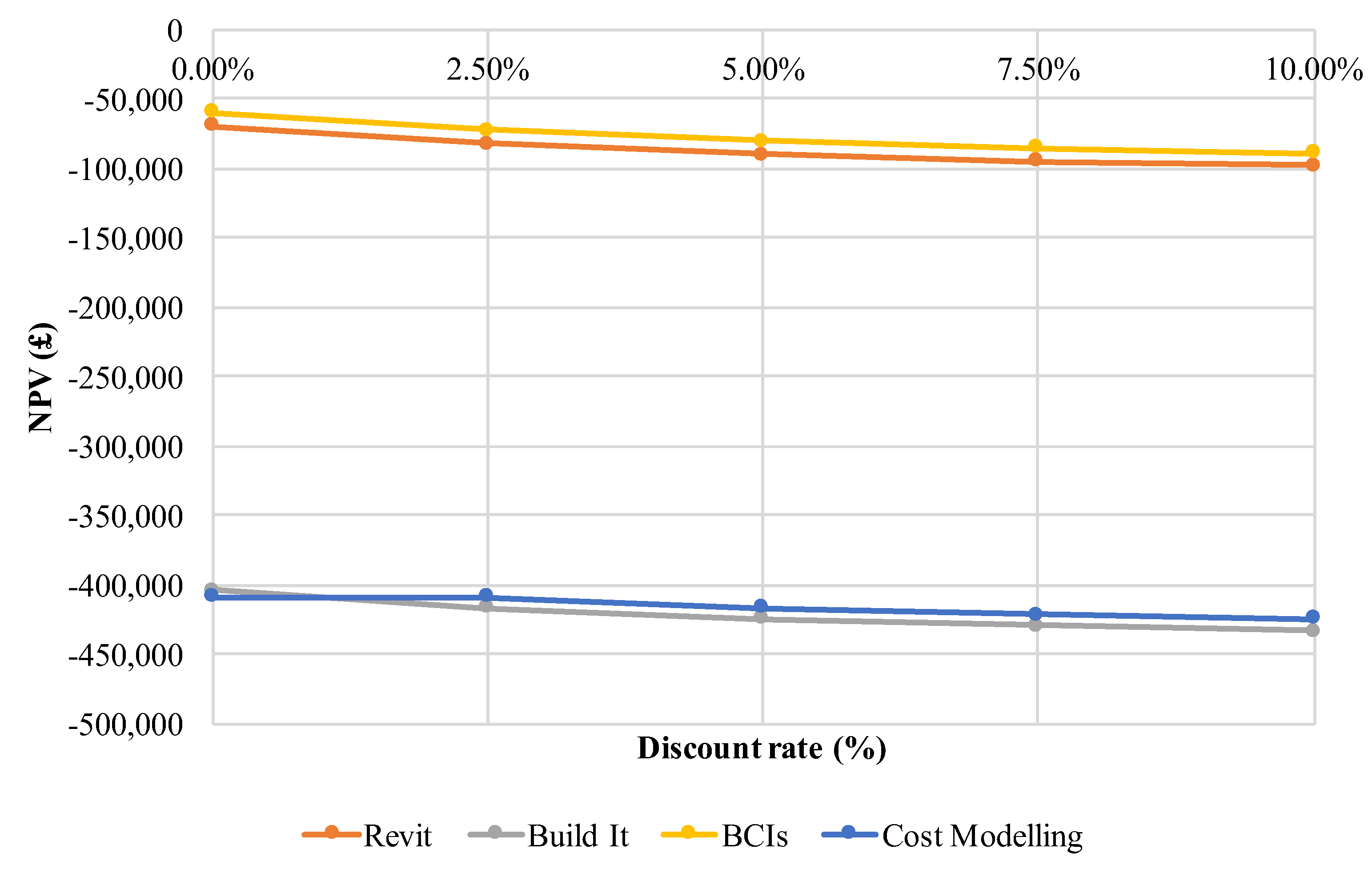
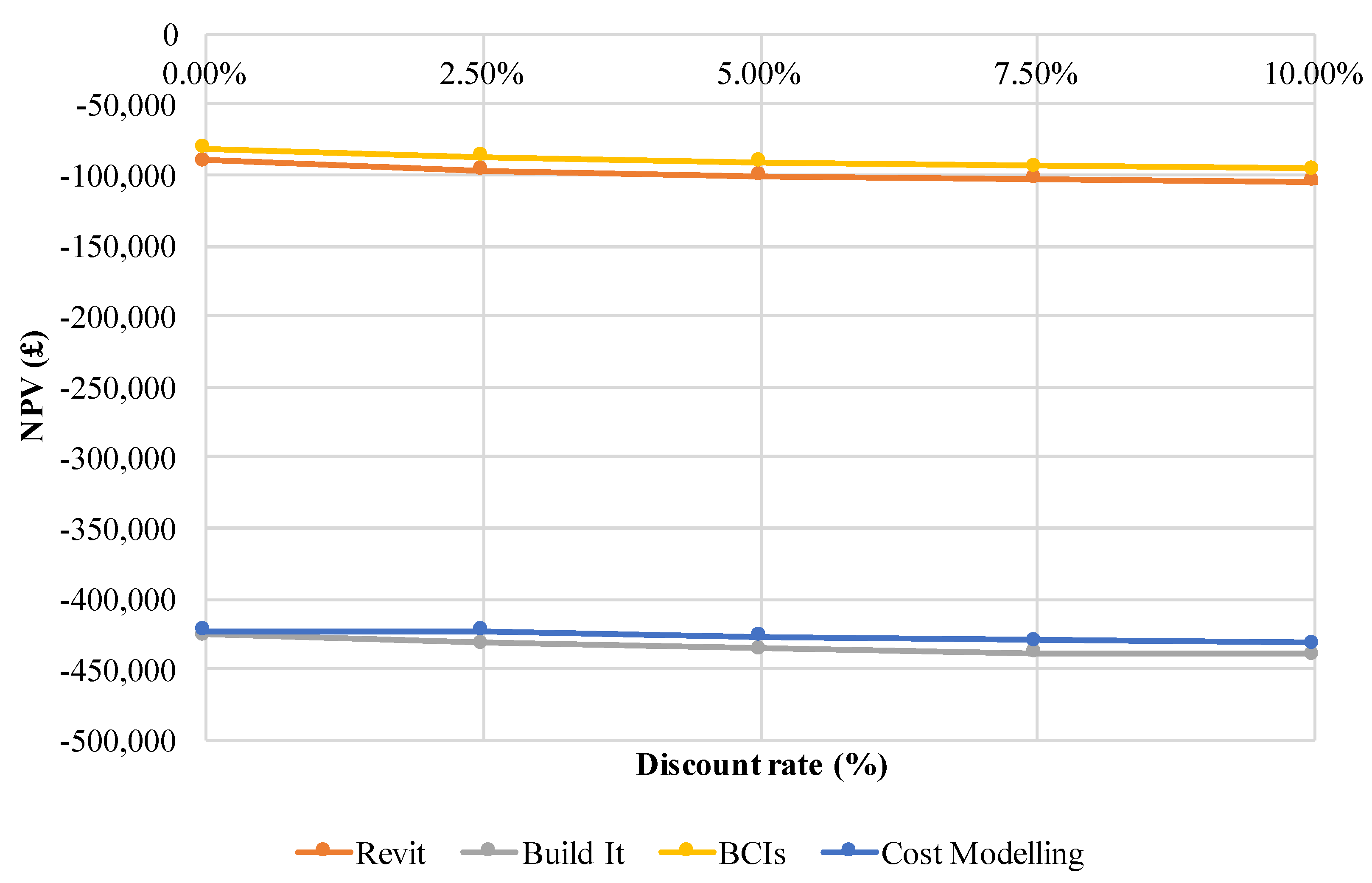
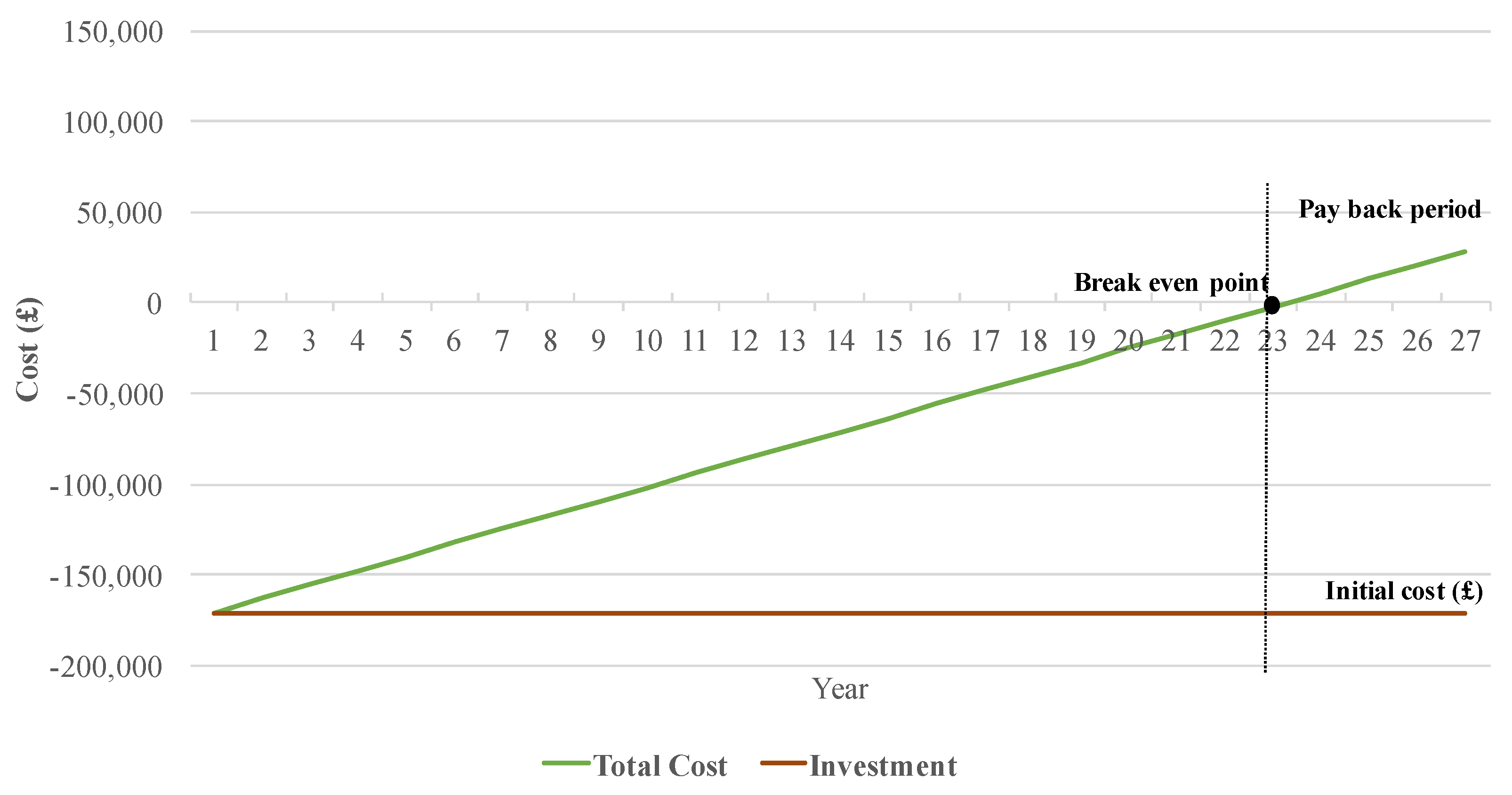
| Option Number | ZEB Supply-Side Options | Examples |
|---|---|---|
| 1 | Reduce site energy use through low-energy building technologies. | Daylighting, high-efficiency HVAC equipment, natural ventilation, evaporative cooling, etc. |
| On-Site Supply Options | ||
| 2 | Use renewable energy sources available within the building’s footprint. | PV, solar hot water, and wind located on the building. |
| 3 | Use renewable energy sources available at the site. | PV, solar hot water, low-impact hydro, and wind located on-site, but not on the building. |
| Off-Site Supply Options | ||
| 4 | Use renewable energy sources available off-site to generate energy on site. | Biomass, wood pellets, ethanol, or biodiesel that can be imported from off-site, or waste streams from on-site processes that can be used on-site to generate electricity and heat. |
| 5 | Purchase off-site renewable energy sources. | Utility-based wind, PV, emissions credits, or other “green” purchasing options. Hydroelectric is sometimes considered. |
| Name of Model | Improved Thermal Efficiency House | Standard House |
|---|---|---|
| Model | 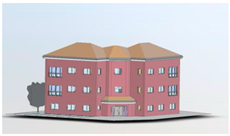 | 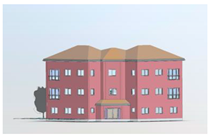 |
| Revit energy analysis result | 133 kWh/m2/year | 142 kWh/m2/year |
| Sources | EUI Values (kWh/m2/year) | Remaining Energy (kWh/year) | Electrical Cost (£) | Reduced Cost (£/year) |
|---|---|---|---|---|
| Standard | 142 | 85,528.02 | 11,118.64 | - |
| Improve Thermal Efficiency | 133 | 80,107.23 | 10,413.94 | 704.70 |
| Insight Software | 124 | 74,691.62 | 9709.91 | 1408.73 |
© 2018 by the authors. Licensee MDPI, Basel, Switzerland. This article is an open access article distributed under the terms and conditions of the Creative Commons Attribution (CC BY) license (http://creativecommons.org/licenses/by/4.0/).
Share and Cite
Kaewunruen, S.; Rungskunroch, P.; Welsh, J. A Digital-Twin Evaluation of Net Zero Energy Building for Existing Buildings. Sustainability 2019, 11, 159. https://doi.org/10.3390/su11010159
Kaewunruen S, Rungskunroch P, Welsh J. A Digital-Twin Evaluation of Net Zero Energy Building for Existing Buildings. Sustainability. 2019; 11(1):159. https://doi.org/10.3390/su11010159
Chicago/Turabian StyleKaewunruen, Sakdirat, Panrawee Rungskunroch, and Joshua Welsh. 2019. "A Digital-Twin Evaluation of Net Zero Energy Building for Existing Buildings" Sustainability 11, no. 1: 159. https://doi.org/10.3390/su11010159
APA StyleKaewunruen, S., Rungskunroch, P., & Welsh, J. (2019). A Digital-Twin Evaluation of Net Zero Energy Building for Existing Buildings. Sustainability, 11(1), 159. https://doi.org/10.3390/su11010159







